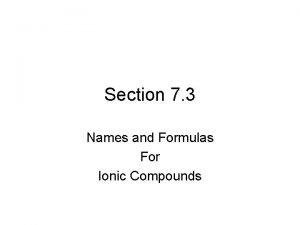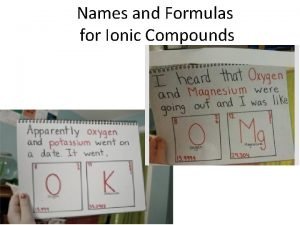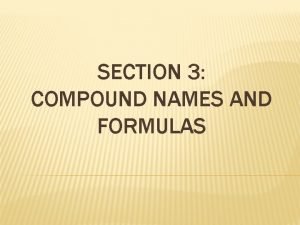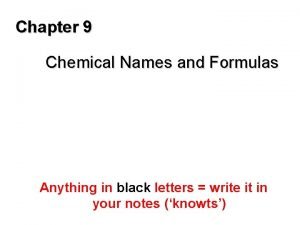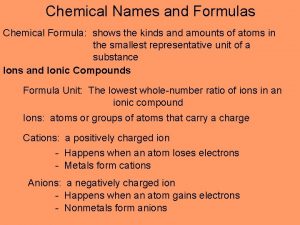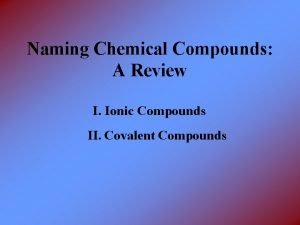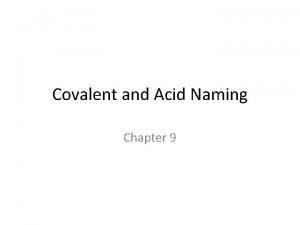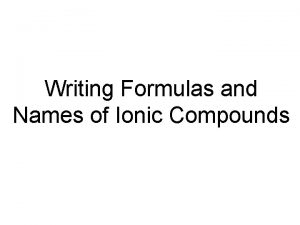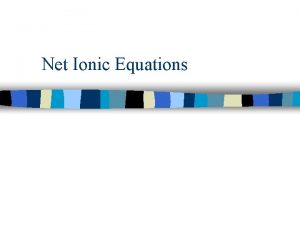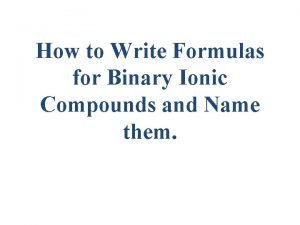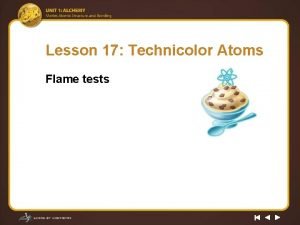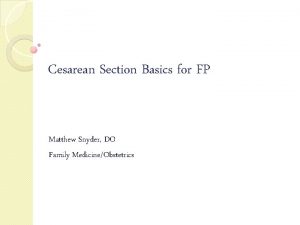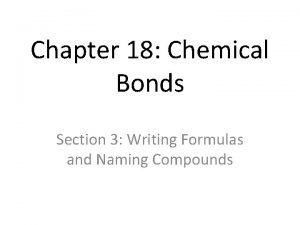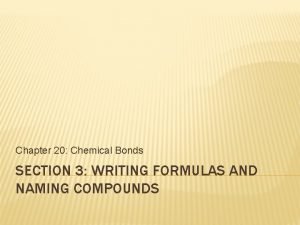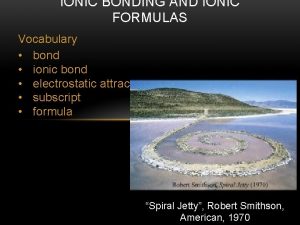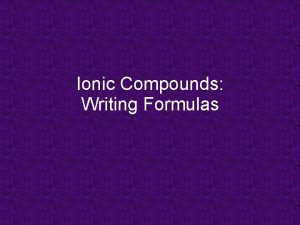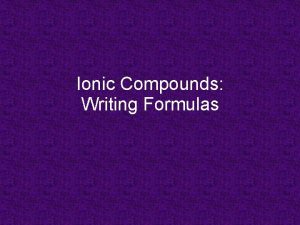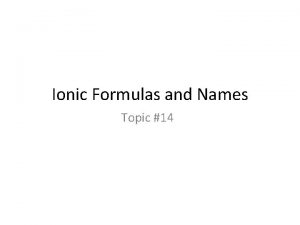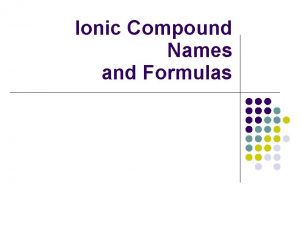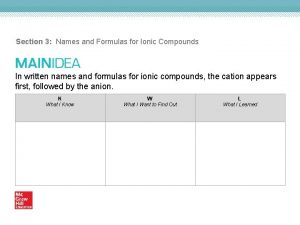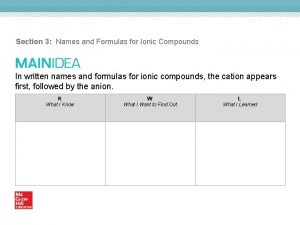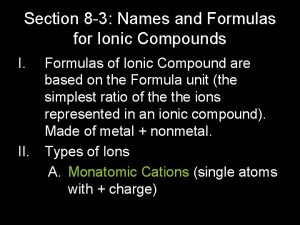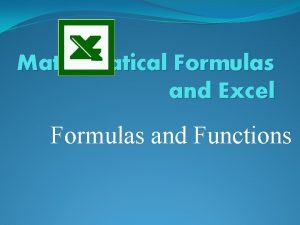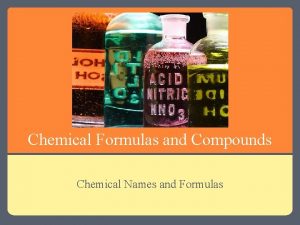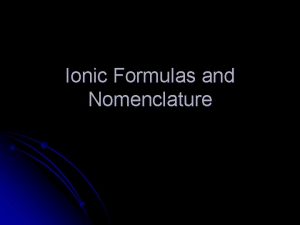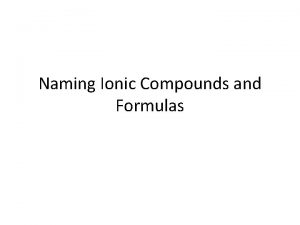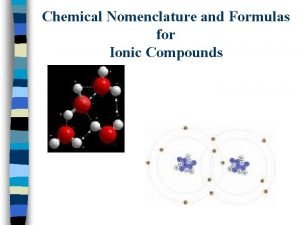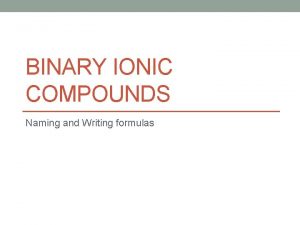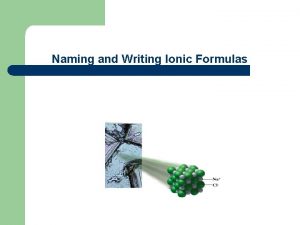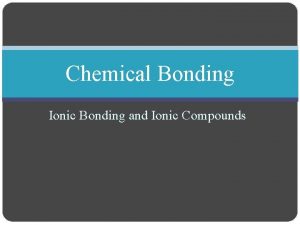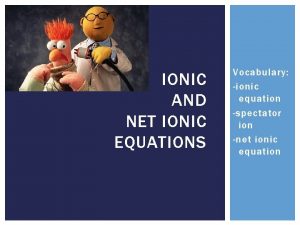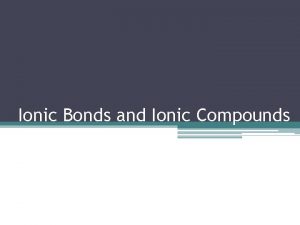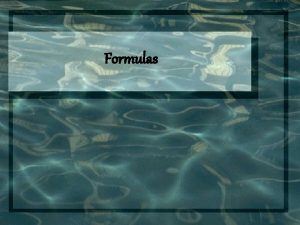Section 7 3 Names and Formulas For Ionic






























- Slides: 30

Section 7. 3 Names and Formulas For Ionic Compounds

Naming Compounds Name of a student _________ first last Name of an ionic compound sodium chloride Which substance lost electrons? Which substance gained electrons?

Formula Unit Chemical compound of an ionic compound Simplest ration of the ions involved

Magnesium Chloride Magnesium group 2 Mg 2+ Chlorine group 17 Cl. Want net charge of zero: Have 2+ and 1 Want 2+ and 2 - so need 2 Cl. Ratio 1: 2 Mg. Cl 2

Ratios Determine the ratio from the formula units Ag 2 S Mg. Cl 2 Al 2 O 3

On Your Own Determine the ratio Sn. F 4 Fe. O

Monatomic Ions One-atom ion Mg 2+ Br. Use the periodic table. What is the formula for beryllium ion? Iodide ion? Nitride ion?

Common Monatomic Ions Group Atoms 1 15 H, Li, Na, K, Rb, 1+ Cs Be, Mg, Ca, Sr, 2+ Ba N, P, As 3 - 16 O, S, Se, Te 2 - 17 F, Cl, Br, I 1 - 2 Charge on Ions

Monatomic Metal Ions Group Common Ions 3 Sc 3+, Y 3+, La 3+ 4 Ti 2+, Ti 3+ 5 V 2+, V 3+ 6 Cr 2+, Cr 3+ 7 Mn 2+, Mn 3+, Tc 2+ 8 Fe 2+, Fe 3+

Continued Group Common Ions 9 Co 2+, Co 3+ 10 Ni 2+, Pd 2+, Pt 4+ 11 Cu+, Cu 2+, Ag+, Au 3+ 12 Zn 2+, Cd 2+, Hg 2+ 13 Al 3+, Ga 2+, Ga 3+, In 2+, In 3+, Tl 3+ 14 Sn 2+, Sn 4+, Pb 2+, Pb 4+

Oxidation Numbers The charge on a monatomic ion Oxidation number or oxidation state Equals the number of electrons transferred from the atom to form the ion Notice some ions have more than one oxidation state – with the d orbital elements

Binary Ionic Compounds Symbol Cation then Anion Subscripts equals number of ions if no subscript then it is 1

How to figure the Formula Write the symbol and charge for each ion Find the ratio of ions in the formula • Overall charge must be zero • Subscripts times the charges sum to zero

Example 7. 1 Determine the formula for the ionic compound formed from potassium and oxygen. Potassium group 1 K+ Oxygen group 16 O 2 Ratio: 2: 1 K 2 O Evaluate: 2 K ions (+1) + 1 O ion (-2) = 2 (+1) + 1(-2) = 2 + (-2) = 0

Example 7. 2 Determine the formula for the compound formed from aluminum ions and sulfide ions. Aluminum group 13 Al 3+ Sulfur group 16 S 2 Ratio: 2: 3 Al 2 S 3 Evaluate: 2 Al ions (3) + 3 S ions (-2) = 2 (3) + 3 (-2) = 6 + (-6) = 0

Practice Write the ionic compound formula. 19. Potassium and iodide 20. Magnesium and chloride 21. Aluminum and bromide 22. Cesium and nitride 19. KI 20. Mg. Cl 2 21. Al. Br 2 22. Cs 3 N

Polyatomic Ionic Compounds Ionic compounds made from more than one atom. Popular ions Ammonium NH 4+ Nitrite NO 2 Nitrate NO 3 Hydroxide OHCyanide CN-

Formulas for Polyatomic Ionic Compounds Mg(NO 3)2 Mg 2+ + (NO 3)- Al(NO 3)3 Al 3+ + (NO 3)- ratio 1: 2 ratio 1: 3 Use parenthesis to surround the polyatomic ion

Practice Write the formula for ionic compounds. 24. Sodium and nitrate 25. Calcium and chlorate 26. Aluminum and carbonate 24. Ratio 1: 1 Na+ + (NO 3)- Na(NO 3) 25. Ratio 1: 2 Ca 2+ + (Cl. O 3)- Ca(Cl. O 3)2 26. Ratio 2: 3 Al 3++(CO 3)2 - Al 2(CO 3)3

Naming Ionic Compounds 1. Name the cation followed by the anion 2. For monatomic cations use the element name 3. For monatomic anions change the suffix to –ide. Rule 1 Cs. Br Cesium Bromide Rule 2 Rule 3

4. To distinguish between multiple oxidation numbers of the same element use (roman numerals) after the symbol. Fe 2+ + O 2 - Fe. O Iron (II) Oxide Fe 3+ + O 2 - Fe 2 O 3 Iron (III) Oxide

5. When the compound contains a polyatomic ions use the polyatomic ion name. Na. OH is sodium hydroxide (OH)- (NH 4)2 S is ammonium sulfide (NH 4)+

Naming Ionic Compounds Determine the cation and anion of the given formula Does the cation have only one oxidation number? Yes Write the name of the cation, then the name of the anion No Wite the name of the cation followed by a Roman numeral to represent the charge, then write the anion name.

Practice Problems Name the following compounds. 28. Na. Br 29. Ca. Cl 2 30. KOH 31. Cu(NO 3)2 32. Ag 2 Cr. O 4

Each Student Make a 5 x 5 chart Across the top write 5 non-metal ions, with one polyatomic anion Along the side list 5 metals, with ammonium ion. Trade charts with another student, name each compound in the boxes. Trade back and check.

Summary A formula unit gives the ratio of cations to anions in the ionic compound. A monatomic ion is formed from one atom. The charge of amonatomic ion is its oxidation number. Roman numerals indicate the oxidation number of cations having multiple possible oxidation states.

Polyatomic ions consist of more then one atom and act as a single unit. To indicate more than one polyatomic ion in a chemical formula, place parentheses around the polyatomic ion and use a subscript.

Practice Problems 34. State the order in which the ions associated with a compound composed of potassium and bromine would be written in the chemical formula and the compound name. 35. Describe the difference between a monatomic ion and a polyatomic ion, and give an example of each.

36. Ion X has a charge of 2+ and ion Y has a charge of 1 -. Write the formula unit of the compound formed from the ions. 37. State the name and formula for the compound formed from Mg and Cl. 38. Write the name and formula for the compound formed from sodium ions and nitrite ions.

Exit Ticket This is the formula for making artificial ocean water often used in saltwater aquariums. Mix 24. 72 g Na. Cl, 0. 67 g KCl, 1. 36 g Ca. Cl, 4. 66 g Mg. Cl 2, 6. 29 g Mg. SO 4 and 0. 18 g Na. HCO 3. Name each ionic compound.
 Section 3 names and formulas for ionic compounds
Section 3 names and formulas for ionic compounds Section 3 names and formulas for ionic compounds
Section 3 names and formulas for ionic compounds Chapter 6 section 3 compound names and formulas answer key
Chapter 6 section 3 compound names and formulas answer key Writing formulas criss-cross method worksheet
Writing formulas criss-cross method worksheet Chemistry chapter 9 chemical names and formulas
Chemistry chapter 9 chemical names and formulas Tribromine octoxide formula
Tribromine octoxide formula Rules for naming ionic compounds
Rules for naming ionic compounds A chemical formula shows the
A chemical formula shows the Monoatomic ion
Monoatomic ion Review naming ionic compounds
Review naming ionic compounds Ionic covalent names chapter 9
Ionic covalent names chapter 9 Writing formulas for ionic compounds worksheet
Writing formulas for ionic compounds worksheet What is a complete ionic equation
What is a complete ionic equation Bunary compound
Bunary compound Writing formulas criss cross method
Writing formulas criss cross method Lesson 17 technicolor atoms flame test worksheet answers
Lesson 17 technicolor atoms flame test worksheet answers Cesarean instruments list with pictures
Cesarean instruments list with pictures Section 3 writing formulas and naming compounds
Section 3 writing formulas and naming compounds Section 3 writing formulas and naming compounds
Section 3 writing formulas and naming compounds Iso 22301 utbildning
Iso 22301 utbildning Typiska drag för en novell
Typiska drag för en novell Nationell inriktning för artificiell intelligens
Nationell inriktning för artificiell intelligens Returpilarna
Returpilarna Varför kallas perioden 1918-1939 för mellankrigstiden?
Varför kallas perioden 1918-1939 för mellankrigstiden? En lathund för arbete med kontinuitetshantering
En lathund för arbete med kontinuitetshantering Adressändring ideell förening
Adressändring ideell förening Tidböcker
Tidböcker Sura för anatom
Sura för anatom Vad är densitet
Vad är densitet Datorkunskap för nybörjare
Datorkunskap för nybörjare Tack för att ni lyssnade bild
Tack för att ni lyssnade bild
